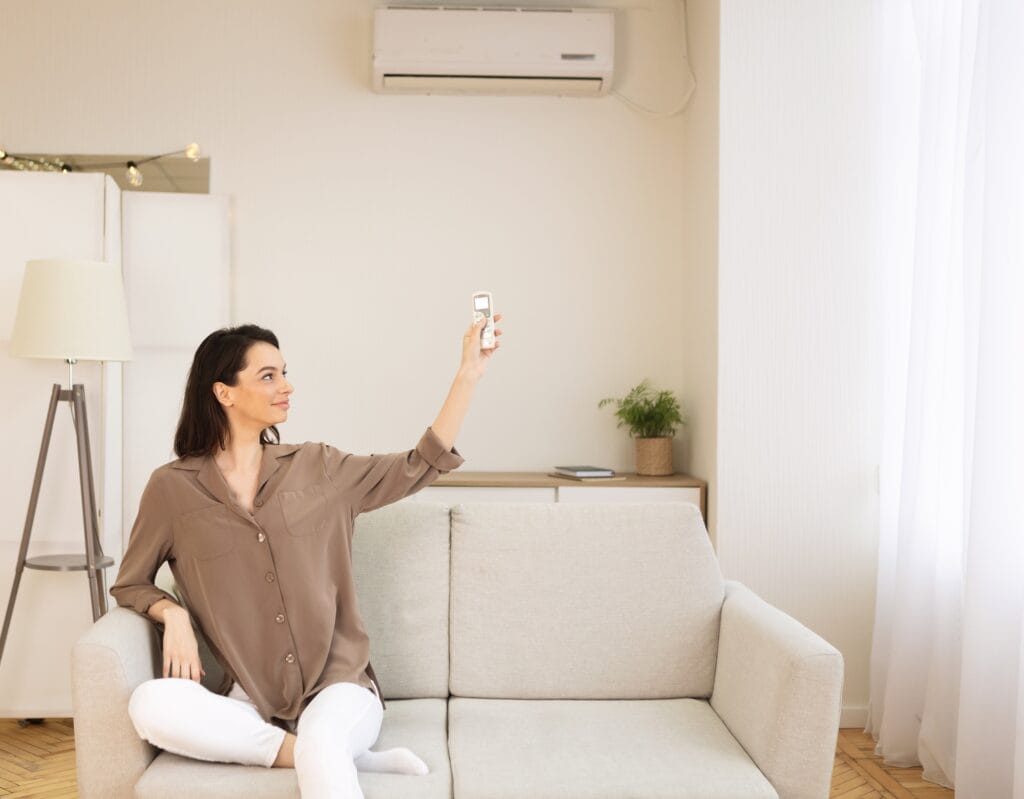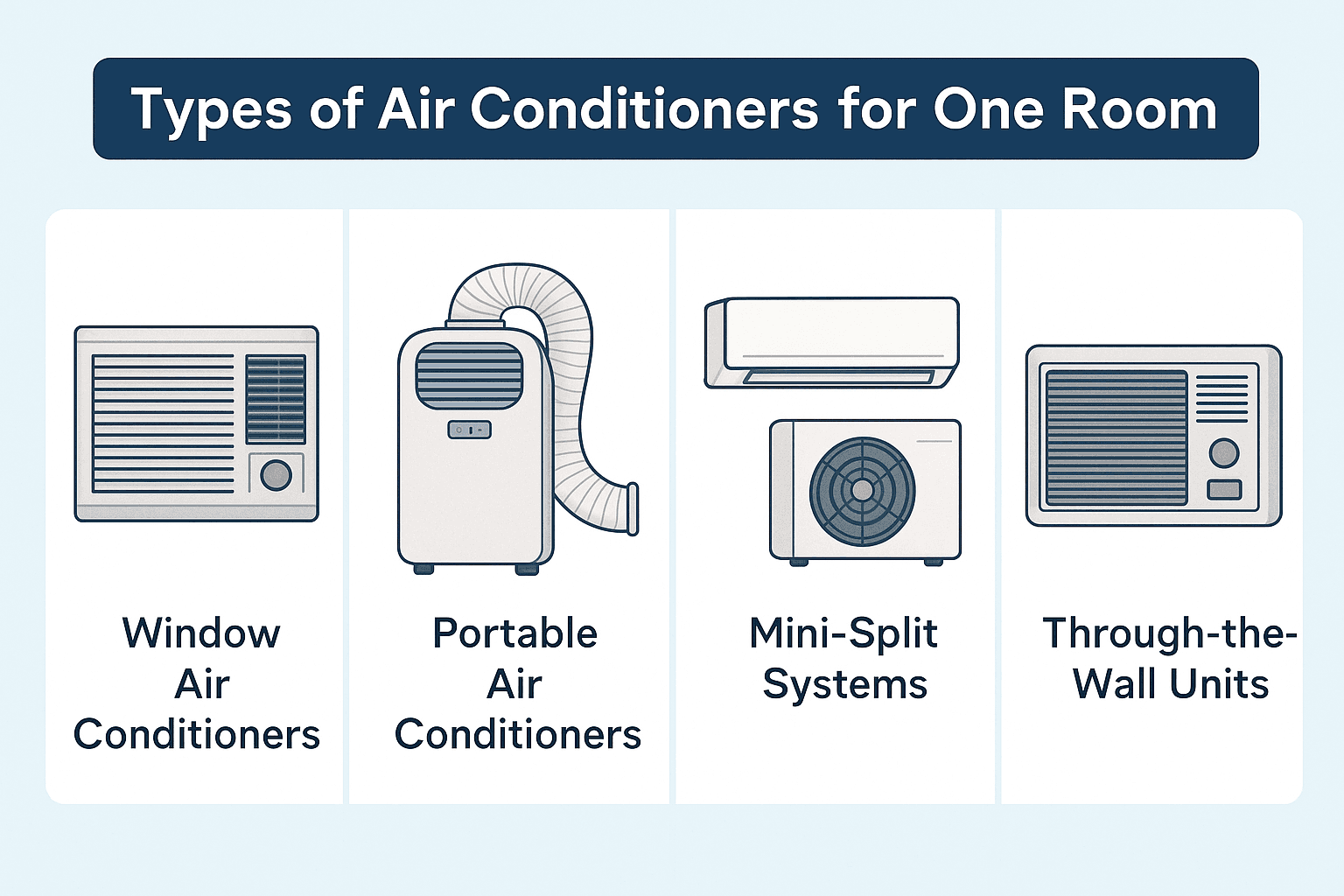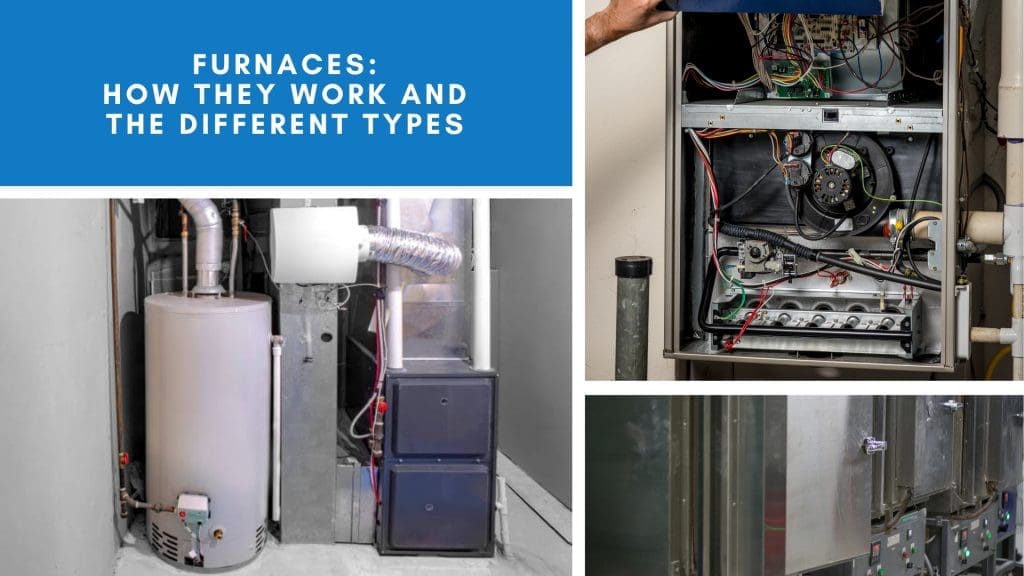Choosing the right Air Conditioner for One Room can be a daunting task. There are many factors to consider, from the size of the room to the type of air conditioner that best suits your needs.
Whether you’re a small business owner, a work-from-home professional, or a busy stay-at-home mom, you need a reliable and efficient cooling solution. You want to ensure your comfort and productivity, without breaking the bank.
This guide is here to help. We’ll delve into the world of room air conditioners, exploring different types and their benefits. We’ll discuss energy efficiency, installation considerations, and how to maximize your comfort with room climate control.

We’ll also touch on maintenance tips to keep your air conditioner running smoothly. And for those who prefer a hands-off approach, we’ll highlight when it’s best to call in the professionals.
So, whether you’re looking to cool a home office, a nursery, or a small retail space, this guide has got you covered. Let’s dive in and find the perfect aircon for your one room.
Understanding Your Single Room Cooling Needs
Before picking an air conditioner, it’s crucial to assess your cooling needs. A room’s size and layout have a significant impact on the cooling requirements. A larger room demands a unit with higher cooling capacity, measured in BTUs.

Consider any unique factors in your space. These might include large windows letting in sunlight or multiple electronic devices generating heat. Understanding these elements will help you choose the right unit that efficiently maintains a pleasant temperature.
Moreover, think about your usage habits. Are you cooling a room during specific hours, like a home office during the day? Or perhaps you need consistent cooling for a nursery? Identifying these needs ensures you select an aircon that fits seamlessly into your life, enhancing comfort and energy efficiency.
Types of Air Conditioners for One Room
Choosing the right type of air conditioner is pivotal for optimizing single-room cooling. With varying designs and functionalities, not every unit fits every room. Let’s dive into the different options available and see how each type caters to specific needs.
Here are the common types of air conditioners suitable for single rooms:
- Window Air Conditioners
- Portable Air Conditioners
- Mini-Split Systems
- Through-the-Wall Units

Window Air Conditioners
Window air conditioners are a classic choice for single-room cooling. They offer simplicity and cost-effectiveness. Installation involves mounting the unit on a window, where it vents the heat outdoors. These units generally serve as an effective and budget-friendly solution, especially in spaces with no central air system.
A key factor is ensuring the window accommodates the unit’s size and weight. Once installed, they efficiently cool small to medium rooms while freeing up floor space. However, note that they may obstruct the view from the window.
Portable Air Conditioners
Portable air conditioners bring flexibility to small space cooling. These units are mobile, allowing you to move them from room to room as needed. Typically, they require a nearby window to vent out hot air, connecting through a hose.
These are ideal for renters or areas where window units aren’t feasible. Despite their convenience, portable units can occupy floor space and may not be as energy-efficient as other options.
Mini-Split Systems
Mini-split systems offer an energy-efficient aircon solution for single rooms without the need for ductwork. They consist of an outdoor compressor connected to an indoor unit mounted on a wall. This setup provides targeted cooling with less energy consumption.
These systems are highly customizable. You can adjust different zones or rooms independently, making them an excellent choice for personalized climate control. Although installation costs are higher, the long-term energy savings can be substantial.
Through-the-Wall Units
Through-the-wall units are similar to window air conditioners but install through an exterior wall. This permanent installation frees up window space and offers a sleek appearance. They are suitable for those who value aesthetics as part of room climate control.
The installation might require professional help to ensure it’s safely integrated into the wall. This method provides efficient cooling for small spaces, with the unit projecting slightly from the wall, maintaining a neat look.
Energy Efficiency and Cost Savings
Energy efficiency in air conditioning not only reduces environmental impact but also trims down utility costs. When choosing an aircon for one room, it’s crucial to consider how energy-efficient the unit is. This directly affects long-term expenses and comfort in your living space.
Look for energy star-rated air conditioners, which are designed to be cost-effective and eco-friendly. They typically have advanced features that optimize performance and minimize energy consumption. These savings can add up significantly over the lifespan of the unit.
Here are some key aspects to consider for energy efficiency:
- BTU and room size compatibility.
- SEER ratings for energy consumption.
- Inverter technology for consistent cooling.
Beyond selecting the right unit, proper maintenance plays a role in energy savings. This includes regular filter cleanings and checking seals around the air conditioner. By following these tips, you can enjoy a more comfortable and efficient home environment.
Understanding BTUs and Room Size
Before buying a room air conditioner, it’s essential to grasp how BTUs (British Thermal Units) relate to room size. BTU measures the cooling capacity of the unit, vital for energy-efficient aircon operation. An air conditioner with the wrong BTU rating can be costly and inefficient.
A unit with too low BTU will struggle to cool the room, consuming more energy as it works harder. Conversely, a unit with excessive BTU will cycle on and off too rapidly, causing inconsistent room climate control and unnecessary wear.
To determine the appropriate BTU, measure your room’s square footage. Consider factors like ceiling height, sun exposure, and room insulation. These will help in deciding the BTU requirement, ensuring you get the optimal performance from your air conditioner.
The Importance of SEER Ratings
SEER (Seasonal Energy Efficiency Ratio) is a key rating that helps gauge an air conditioner’s efficiency. Higher SEER ratings indicate greater energy efficiency, resulting in lower energy bills and reduced environmental footprint. It’s a valuable metric when considering long-term cost savings in your AC investment.
Though units with higher SEER ratings might have a higher upfront cost, they offer better long-term savings on utilities. Over time, the initial investment is recouped through reduced energy expenditure. This makes high-SEER units a smart choice for cost-conscious consumers.
When selecting a unit, consider your local climate, as it influences how SEER ratings translate into real-world savings. In warmer climates, the savings from a high-SEER unit can be more pronounced, making it an even wiser choice for energy-efficient air conditioning solutions.
Installation Considerations
Installing a room air conditioner requires careful planning. Proper installation is key to maximizing efficiency and comfort. It ensures the unit operates as intended and extends its lifespan, providing consistent climate control.
Begin by choosing an appropriate spot for your unit. This affects airflow and overall effectiveness. Consider factors like access to power outlets and obstacles that might block airflow. Placement can hugely impact the room’s cooling efficiency and energy consumption.
Remember, the installation process varies depending on the unit type. Portable units offer easier setups, while window and through-the-wall units might need more precision. Some situations might even call for professional installation services to guarantee optimal performance.
Do All AC Units Need a Window?
Not all AC units require a window for installation. Window air conditioners obviously do, but other types offer flexibility. Portable air conditioners and mini-split systems, for example, don’t need a window. They offer alternative options, particularly useful for rooms without windows.
Portable units use a venting hose that can be placed through any exterior opening. Mini-split systems use an outdoor condenser, avoiding the need for window access. This versatility allows efficient cooling in diverse living spaces, catering to unique room setups and limitations.
Professional vs. DIY Installation
The decision between professional and DIY installation depends on personal skill, time, and comfort level. Simple units like portable air conditioners can often be set up independently, making them ideal for quick and easy deployment.
However, more complex systems may benefit from professional expertise. Proper installation ensures safety and maximizes performance, especially for systems like mini-splits. Hiring professionals can also prevent potential costly errors and ensure adherence to safety standards.
Ultimately, the choice hinges on balancing confidence in tackling the task versus the assurance that comes from professional installation. Assess your capabilities and the complexity of the task to make an informed choice.
Maximizing Comfort with Room Climate Control
Achieving the perfect room climate involves more than just setting the temperature. It requires a fine balance of airflow, humidity control, and temperature consistency. Proper room climate control significantly boosts comfort in your home or office.
One critical aspect is ensuring uniform air distribution throughout the space. This prevents hot or cold spots and enhances overall comfort. Using the right equipment can significantly aid in achieving a balanced environment.
Integrating technology enhances the ability to maintain your ideal climate. Modern systems provide precision, allowing personalized comfort and efficient energy use. Implement these strategies, and you’ll enjoy a pleasant and productive environment.
Air Conditioner Redirect and Airflow Optimization
Optimizing airflow can transform a good air conditioner into a great one. An air conditioner redirect accessory can help direct airflow where it’s needed most. This can be vital in rooms where airflow naturally gets blocked by furniture or walls.
An air conditioner that blows upward can be a game-changer. This design helps distribute air more evenly throughout the room. It prevents cold air from simply settling near the floor, ensuring everyone in the room enjoys a consistent temperature.
Incorporating additional fans or a room-to-room transfer duct can also enhance circulation. They help move treated air throughout the space, improving temperature balance and reducing energy costs. Effective airflow means a more comfortable and energy-efficient room.
Smart Features and Remote Management
Smart features have revolutionized room climate control. Modern air conditioners offer remote management, allowing you to adjust settings from anywhere. This convenience not only saves time but also helps maintain the perfect indoor climate effortlessly.
Smart thermostats offer even greater control and energy savings. These devices learn your preferences, automatically adjusting to suit your comfort needs. They optimize energy use, reducing electricity bills while maintaining the desired comfort level.
The integration of smart technology in HVAC systems is a game-changer for modern homes. It empowers homeowners to take full control of their indoor environments, ensuring comfort without compromise. When searching for a single-room AC, consider smart-enabled models for optimal control and efficiency.
Maintenance and Upkeep for Peak Performance
Regular maintenance is key to extending the life of your air conditioner. It also ensures it runs efficiently, saving energy and money. A well-maintained unit offers consistent comfort with fewer interruptions.
Ignoring maintenance can lead to reduced performance and higher utility bills. Over time, dust and debris can accumulate, affecting airflow and efficiency. Simple upkeep measures can prevent such issues, keeping the system running smoothly.
Investing time in routine care pays off by maximizing your air conditioner’s lifespan and functionality. Good maintenance means fewer repairs and a more reliable system. It’s an investment in comfort and peace of mind.
Routine Cleaning and Filter Replacement
Cleaning your air conditioner is more than just a chore. It’s an essential part of maintaining its efficiency. Dust and dirt can clog the filter, reducing airflow and straining the unit.
Regular filter replacements are crucial for optimal performance. A clean filter ensures better air quality and efficient cooling. Most manufacturers recommend checking and replacing filters every one to three months.
Doing this routinely helps prevent breakdowns and keeps your energy costs low. It’s a small effort with a significant impact on your comfort and the unit’s longevity. Keep your air conditioner in top shape with simple, regular cleaning.
Professional Services and Support
While some maintenance tasks can be DIY-friendly, others require a professional touch. Experts can perform detailed inspections, identifying potential issues early. This proactive approach can save money and avoid unexpected breakdowns.
Routine professional servicing can also include checking refrigerant levels and ensuring all components function properly. Having an HVAC specialist involved assures you of a well-tuned system.
Choosing trusted professionals like LC Heating and Air Conditioning in Hollywood guarantees quality service. We offer comprehensive support, ensuring your air conditioner stays efficient year-round. Rely on experts for peace of mind and dependable performance.
Additional Cooling Solutions and Alternatives
Sometimes, a single room air conditioner might not be enough, especially in larger homes. Considering additional cooling solutions can enhance comfort across multiple spaces. These alternatives can provide a more comprehensive approach to keeping your home cool.
One option is to use strategic cooling methods like fans and transfer ducts. These not only improve air circulation but also help distribute the conditioned air more effectively. Integrating such systems can reduce the workload of your air conditioner, making it run more efficiently.
Exploring various cooling methods can lead to greater energy savings and improved comfort. It’s worth looking at these alternatives as complementary solutions. Together, they can maintain a pleasant indoor climate while supporting your primary air conditioner.
Room to Room Transfer Ducts and Fans
Room to room transfer ducts are an innovative solution for sharing cool air between spaces. By installing these, you can better balance the temperatures in adjacent rooms. This system uses simple ductwork and fans to redirect airflow, enhancing overall cooling efficiency.
Fans, when strategically placed, can also aid in cooling. Ceiling fans, for instance, circulate air effectively, creating a wind-chill effect. This allows you to set the thermostat a bit higher, saving on energy costs without sacrificing comfort.
These solutions work best in conjunction with a primary air conditioning system. They act as support, optimizing air distribution throughout your home. Ultimately, they help maintain a more consistent and comfortable environment.
Non-Traditional AC Options
For those looking to step away from conventional units, non-traditional air conditioning options offer exciting alternatives. Innovations like evaporative coolers and solar-powered AC units provide unique benefits. Evaporative coolers, for instance, work well in dry climates, using water to cool air.
Solar-powered air conditioners utilize renewable energy, reducing electricity costs and environmental impact. These systems are gaining popularity for their sustainability and efficiency. They can be particularly advantageous in sunny climates, leveraging abundant solar energy.
Considering non-traditional options might suit specific needs or preferences. They provide flexibility and can align better with eco-conscious values. Exploring these choices can lead to new and effective ways to cool your space.
Conclusion: Choosing the Best Air Conditioner for One Room to Fit Your Space Perfectly.
Selecting the ideal air conditioner for your single room involves careful consideration of several factors. Understanding your cooling needs, space constraints, and budget are crucial first steps. With various types of air conditioners available, from mini-split systems to window units, you have options to suit any scenario.
Ultimately, the best choice will enhance comfort while optimizing energy use. Prioritize energy efficiency, ease of installation, and innovative features like smart controls. Whether it’s maintaining a comfortable workspace or creating a serene home environment, the right aircon solution will contribute significantly to your comfort and peace of mind.
FAQs
Navigating the world of room air conditioners can stir up a lot of questions. From figuring out cooling loads to enhancing air quality, there’s much to learn. Here, we address some of the common questions to help you make informed decisions. It’s all about ensuring comfort and energy efficiency in your space. Let’s dive into these frequently asked questions to make your air conditioning journey smoother.
How do I calculate the cooling load for my room?
To determine your room’s cooling load, measure its square footage and multiply by 20 BTU per square foot. Adjust for high ceilings, windows, and other heat sources.
Can I use a mini air conditioner in a rented space?
Absolutely! Mini air conditioners are great for rented spaces. Their easy installation and removal make them perfect without altering your rental unit permanently.
What are the benefits of energy star-rated air conditioners?
Energy Star-rated air conditioners deliver exceptional efficiency, reducing energy use and saving on utility bills. They also lessen environmental impact, promoting a greener lifestyle.
How can I improve the air quality with my room air conditioner?
Enhancing air quality is achievable by using air conditioners equipped with HEPA filters. Regularly cleaning and replacing these filters ensures optimal air purification.


